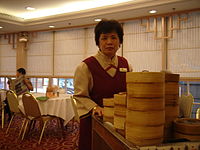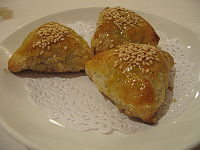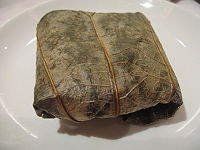- Dim sum
-
For other uses, see Dimsum (disambiguation).
Dim sum 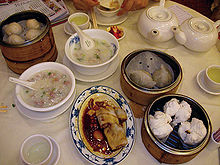
Typical dim sum breakfast in Hong Kong.
From left to right and top to bottom:
har gau, jasmine tea, chicken and vegetable congee, steamed dumpling, rice noodle roll (on plate), cha siu baauTraditional Chinese 點心 Simplified Chinese 点心 Hanyu Pinyin diǎn xin Cantonese Jyutping dim2 sam1 Transcriptions Mandarin - Hanyu Pinyin diǎn xin Min - Hokkien POJ tiám-sim Cantonese (Yue) - Jyutping dim2 sam1 - Yale Romanization dím sām Dim sum refers to a style of Chinese food prepared as small bite-sized or individual portions of food traditionally served in small steamer baskets or on small plates. Dim sum is also well known for the unique way it is sometimes served in some restaurants, where fully cooked and ready-to-serve dim sum dishes would be pushed around on steam carts by servers who go around the restaurant offering the dishes to customers and marking orders on a card on each customer's table.
Going for dim sum is usually known in Cantonese as going to "drink tea" (yum cha, 飲茶), as tea is typically served with dim sum.
Contents
History
Dim sum is usually linked with the older tradition from yum cha (tea tasting), which has its roots in travelers on the ancient Silk Road needing a place to rest. Thus teahouses were established along the roadside. Rural farmers, exhausted after working hard in the fields, would go to teahouses for a relaxing afternoon of tea. At first, it was considered inappropriate to combine tea with food, because people believed it would lead to excessive weight gain. People later discovered that tea can aid in digestion, so teahouse owners began adding various snacks.[citation needed]
The unique culinary art of dim sum originated with the Cantonese in southern China, who over the centuries transformed yum cha from a relaxing respite to a loud and happy dining experience. In Hong Kong, and in most cities and towns in Guangdong province, many restaurants start serving dim sum as early as five in the morning. It is a tradition for the elderly to gather to eat dim sum after morning exercises. For many in southern China, yum cha is treated as a weekend family day. More traditional dim sum restaurants typically serve dim sum until mid-afternoon (around the time of a traditional Western 3:00 coffee break). However, in modern society it has become common place for restaurants to serve dim sum at dinner time, various dim sum items are even sold as take-out for students and office workers on the go.
While dim sum (literally meaning: point of the heart) was originally not a main meal, only a snack, and therefore only meant to touch the heart, it is now a staple of Chinese dining culture, especially in Hong Kong. Health officials have recently criticized the high amount of saturated fat and sodium in some dim sum dishes, warning that steamed dim sum should not automatically be assumed to be healthy.[1] Health officials recommend balancing fatty dishes with boiled vegetables without sauce.[2]
Cuisine
Serving dim sum in a restaurant in Hong Kong
Traditional dim sum includes various types of steamed buns such as cha siu baau, dumplings and rice noodle rolls (cheong fun), which contain a range of ingredients, including beef, chicken, pork, prawns and vegetarian options. Many dim sum restaurants also offer plates of steamed green vegetables, roasted meats, congee porridge and other soups. Dessert dim sum is also available and many places offer the customary egg tart.
Dim sum can be cooked by steaming and frying, among other methods. The serving sizes are usually small and normally served as three or four pieces in one dish. It is customary to order family style, sharing dishes among all members of the dining party. Because of the small portions, people can try a wide variety of food.
Dishes
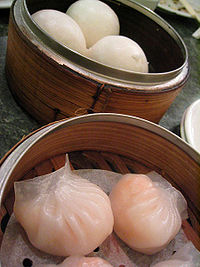 Dim-sum dumpling in Chicago
Dim-sum dumpling in Chicago Lo mai gai wrapped in lotus leaf
Lo mai gai wrapped in lotus leaf
Dim sum restaurants have a wide variety of dishes, usually several dozen. Among the standard fare of dim sum are the following:
Main
- Gao / Jiao (餃, Dumpling; 餃子 jiao zi): Jiao zi is a standard in most teahouses. They are made of ingredients wrapped in a translucent rice flour or wheat starch skin, and are different from jiaozi found in other parts of China. Though common, steamed rice-flour skins are quite difficult to make. Thus, it is a good demonstration of the chef's artistry to make these translucent dumplings. There are also dumplings with vegetarian ingredients, such as tofu and pickled cabbage.
- Shrimp Dumpling (蝦餃 ha gaau): A delicate steamed dumpling with whole or chopped-up shrimp filling and thin wheat starch skin.
- Chiu-chao style dumplings (潮州粉果 chiu-chau fan guo): A dumpling said to have originated from the Chaozhou prefecture of eastern Guangdong province, it contains peanuts, garlic, chives, pork, dried shrimp, Chinese mushrooms in a thick dumpling wrapper made from glutinous rice flour or Tang flour. It is usually served with a small dish of chili oil.
- Potsticker (鍋貼, gwoh tip / guo tie): Northern Chinese style of dumpling (steamed and then pan-fried jiaozi), usually with meat and cabbage filling. Note that although potstickers are sometimes served in dim sum restaurants, they are not considered traditional Cantonese dim sum.
- Shaomai (燒賣 siu maai): Small steamed dumplings with either pork, prawns or both inside a thin wheat flour wrapper. Usually topped off with crab roe and mushroom.
- Haam Sui Gaau (鹹水餃, salt-water (i.e. savoury) stuffed-dumpling, alternatively 鹹水角 (haam sui gok): deep fried oval-shaped dumpling made with rice-flour and filled with pork and chopped vegetables. The rice-flour surrounding is sweet and sticky, while the inside is slightly salty.
- Bau (包 bau or 包子 bao zi): Baked or steamed, these fluffy buns made from wheat flour are filled with food items ranging from meat to vegetables to sweet bean pastes.
- Char siu baau (叉燒包, cha siu baau): the most popular bun with a Cantonese barbecued pork filling. It can be either steamed to be fluffy and white or baked with a light sugar glaze to produce a smooth golden-brown crust.
- Shanghai steamed buns (上海小籠包 seong hoi siu lung baau): These dumplings are filled with meat or seafood and are famous for their flavor and rich broth inside. These dumplings are originally Shanghainese so they are not considered traditional Cantonese dim sum. They are typically sold with pork as a filling.
- Rice noodle rolls or cheong fan (腸粉 cheong fan): These are wide rice noodles that are steamed and then rolled. They are often filled with different types of meats or vegetables inside but can be served without any filling. Rice noodle rolls are fried after they are steamed and then sprinkled with sesame seeds. Popular fillings include beef, dough fritter, shrimp, and barbecued pork. Often topped with a sweetened soy sauce.
- Phoenix claws (鳳爪 fung zao): These are chicken feet, deep fried, boiled, marinated in a black bean sauce and then steamed. This results in a texture that is light and fluffy (due to the frying), while moist and tender. Fung zau are typically dark red in color. One may also sometimes find plain steamed chicken feet served with a vinegar dipping sauce. This version is known as "White Cloud Phoenix Claws" (白雲鳳爪, baak wan fung jaau).
- Steamed meatball (牛肉球 ngau4 juk6 kau4): Finely-ground beef is shaped into balls and then steamed with preserved orange peel and served on top of a thin bean-curd skin.
- Spare ribs: In the west, it is mostly known as spare ribs collectively. In the east, it is Char siu when roasted red, or (排骨 paai4 gwat1, páigǔ) when roasted black. It is typically steamed with douchi or fermented black beans and sometimes sliced chilli.
- Lotus leaf rice (糯米雞 lo mai gai): Glutinous rice is wrapped in a lotus leaf into a triangular or rectangular shape. It contains egg yolk, dried scallop, mushroom, water chestnut and meat (usually pork and chicken). These ingredients are steamed with the rice and although the leaf is not eaten, its flavour is infused during the steaming. Lo mai gai is a kind of rice dumpling. A similar but lighter variant is known as "Pearl Chicken" (珍珠雞 jan jyu gai).
- Congee (粥 juk1): Thick, sticky rice porridge served with different savory items. The porridge one will see most often is "Duck Egg and Pork Porridge" (皮蛋瘦肉粥 "pei daan sau juk zuk")
- Sou (酥 sou): A type of flaky pastry. Char siu is one of the most common ingredient used in dim sum style sou. Another common pastry seen in restaurants are called "Salty Pastry" (鹹水角 "haam sui gok") which is made with flour and seasoned pork.
- Taro dumpling (芋角 wu gok): This is made with mashed taro, stuffed with diced shiitake mushrooms, shrimp and pork, deep-fried in crispy batter.
- Crispy fried squid (魷魚鬚 yau yu sou): Similar to fried calamari, the battered squid is deep-fried. A variation of this dish may be prepared with a salt and pepper mix. In some dim sum restaurants, octopus is used instead of squid.
- Rolls (捲)
- Spring roll (春捲 cheun gyun): a roll consisting of various types of vegetables — such as sliced carrot, cabbage, mushroom and wood ear fungus — and sometimes meat are rolled inside a thin flour skin and deep fried.
- Tofu skin roll (腐皮捲 fu pei guen): a roll made of Tofu skin
- Cakes (糕)
- Turnip cake (蘿蔔糕 lo baak gou): cakes are made from mashed daikon radish mixed with bits of dried shrimp and pork sausage that are steamed and then cut into slices and pan-fried.
- Taro cake (芋頭糕 wu tao gou): cakes made of taro.
- Water chestnut cake (馬蹄糕 ma tai gou): cakes made of water chestnut. It is mostly see-through and clear. Some restaurants also serve a variation of water chestnut cake made with bamboo juice.
- Chien chang go (千層糕 cin cang gou): "Thousand-layer cake", a dim sum dessert made up of many layers of sweet egg dough.
- zh:灌湯餃(kwun tong gau or goon tong gau): soup with pork, shrimp and dumpling.
Sweets
- Egg tart (蛋撻 daan taat): composed of a base made from either a flaky puff pastry type dough or a type of non-flaky cookie dough with an egg custard filling, which is then baked. Some high class restaurants put bird's nest on top of the custard. In other places egg tarts can be made of a crust and a filling of egg whites and some where it is a crust with egg yolks. Some egg tarts now have flavors such as taro, coffee, and other flavors. There are also different kinds of crust. There is also a flaky crisp outer crust with layers and layers of crunchy crumbs.
- Jin deui or Matuan (煎堆 or 麻糰): Especially popular at Chinese New Year, a chewy dough filled with red bean paste, rolled in sesame seeds, and deep fried.
- Dou fu fa (豆腐花): A dessert consisting of silky tofu served with a sweet ginger or jasmine flavored syrup.
- Mango pudding (芒果布甸 mong guo bou din): A sweet, rich mango-flavoured pudding usually with large chunks of fresh mango; often served with a topping of evaporated milk.
- Sweet cream buns (奶皇包 naai5 wong4 baau1): Steamed buns with milk custard filling.
- Malay Steamed Sponge Cake (馬拉糕 ma5 laai1 gou1): A very soft steamed sponge cake flavoured with molasses.
- Longan Tofu: almond-flavoured tofu served with longans, usually cold.
Tea service
The drinking of tea is as important to dim sum as the food. The type of tea to serve on the table would be typically one of the first things the server would ask dining customers. Several types of tea is served during dim sum :
Chrysanthemum tea – Chrysanthemum tea does not actually contain any tea leaves. Instead it is a flower-based tisane made from chrysanthemum flowers of the species Chrysanthemum morifolium or Chrysanthemum indicum, which are most popular in East Asia. To prepare the tea, chrysanthemum flowers (usually dried) are steeped in hot water (usually 90 to 95 °C after cooling from a boil) in either a teapot, cup, or glass. However, Chrysanthemum flowers are often paired with Pu-erh tea, and this is often referred to as guk pou or guk bou (菊普; pinyin: jú pǔ).
Green tea – Freshly picked leaves only go through heating and drying processes, but do not undergo fermentation. This enables the leaves to keep their original green color and retain most natural substances like polyphenols and chlorophyll contained within the leaves. This kind of tea is produced all over China and is the most popular category of tea. Representative varieties include Dragon Well (Long Jing) and Biluochun from Zhejiang and Jiangsu Provinces respectively.
Oolong tea – The tea leaves are partially fermented, imparting to them the characteristics of both green and black teas. Its taste is more similar to green tea than black tea, but has less a "grassy" flavor than green tea. The three major oolong-tea producing areas are on the southeast coast of China e.g. Fujian, Guangdong and Taiwan.
Pu-erh or Puer tea – The tea have undergone years of fermentation, giving them a unique earthy flavor. This variety of tea is usually compressed into different shapes like bricks, discs and bowls.
Scented teas – There can be various mixtures of flowers with green tea, black tea or oolong tea. Flowers used include jasmine, gardenia, magnolia, grapefruit flower, sweet-scented osmanthus and rose. There are strict rules about the proportion of flowers to tea. Jasmine tea is the most popular type of scented tea, and is often the most popular type of tea served at yum cha establishments.
Added information on teas
The above teas are produced in most of China. Chinese tea bushes (Camellia sinensis) are cultivated in the mountain areas of tropical and subtropical regions or wherever there is proper climate, sufficient humidity, adequate sunshine and fertile soil. Chinese tea is classified in many ways, e.g., quality, method of preparation or place of production. The main processing methods include fermentation (oxidation), heating, drying and addition of other ingredients like flowers, herbs or fruits. These help to develop the special flavor of the raw tea leaves.
Various preparation methods mean different teas have different bioactive substances. For example, green tea only has limited processing so it retains a relatively high content of natural ingredients, meaning that green tea has stronger anti-aging, anti-cancer and anti-bacterial properties. Oolong tea, which is partially fermented, is quite potent in breaking down protein and fat, aiding weight loss. Red tea that has undergone the full fermentation process has lost 90% of its polyphenols but retains its high caffeine content.[3]
Restaurants and pricing
One aspect that many find unique to dim sum is the way it is served in specialized "dim sum restaurants or teahouses", where fully cooked and ready-to-serve dim sum dishes would be pushed around on steam carts by servers who go around the restaurant offering the dishes to customers. Pricing of dishes at these types of restaurants may vary, but traditionally the dishes are classified as "small", "medium", "large", or special order (a menu item not typically considered dim sum fare, such as a plate of chow mein). For example, a basket of dumplings may be considered a small dish, while a bowl of congee or plate of Lo mai gai may be considered a large dish. Dishes are then priced accordingly by dish size. Such types of restaurants normally record the dishes on a bill at the table. Not only is this tidier, it also prevents patrons from cheating by concealing or stealing the plates. Servers in some restaurants use distinct stamps so that sales statistics for each server can be recorded. Another way of pricing the food consumed is to use color of the dishes left on the patron's table as a guide similar to what is used in some sushi restaurants.
Other Chinese restaurants may not offer dim sum on the steam push carts and instead offer it a la carte. Prices of each dim sum dish may then vary depending on the actual dish ordered.
Etiquette
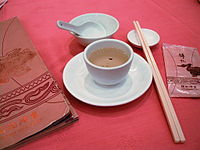 A typical set of eating utensils for yum cha
A typical set of eating utensils for yum cha Main article: Yum cha
Main article: Yum chaThere are common tea-drinking and eating practices or etiquette that Chinese people commonly recognize and use. These are practiced not only during dim sum meals but during other types of Chinese meals as well.
It is customary to pour tea for others during dim sum before filling one's own cup. A custom unique to the Cantonese is to thank the person pouring the tea by tapping the bent index finger if you are single, or by tapping both the index and middle finger if you are married, which symbolizes 'bowing' to them.[citation needed]
This is said to be analogous to the ritual of bowing to someone in appreciation. The origin of this gesture is described anecdotally: an unidentified Emperor went to yum cha with his friends, outside the palace; not wanting to attract attention to himself, the Emperor was disguised. While at yum cha, the Emperor poured his companion some tea, which was a great honor. The companion, not wanting to give away the Emperor's identity in public by bowing, instead tapped his index and middle finger on the table as sign of appreciation[citation needed].
Given the number of times tea is poured in a meal, the tapping is a timesaver in loud restaurants or lively company, as an individual being served might be speaking to someone else or have food in their mouth.
Leaving the pot lid open is another common way of attracting a server's attention and indicates a request for the server to pour hot water into the tea pot.
Fast food
Two women picking microwave-cooked dim sum from the freezer in Circle K, Hong Kong.
Certain kinds of instant dim sum have come onto the market in Hong Kong, Mainland China, Taiwan and Singapore. People can enjoy snacks after a 3-minute defrosting and reheating of the instant dim sum in a microwave oven.
Some stalls serve "street dim sum" which usually consists of dumplings or meatballs steamed in a large container, but served on a bamboo skewer. The customer can dip the whole skewer into a sauce bowl and eat while standing or walking.
Dim sum can be purchased from major grocery stores in most countries with a Chinese population. These dim sum can be easily cooked by steaming or microwaving. Major grocery stores in Hong Kong, Philippines, Singapore, Taiwan, Mainland China, Malaysia, Brunei, Thailand, Australia, United States and Canada have a variety of dim sum stocked at the shelves. These include dumplings, siu maai, bau, cheong fun, lo bak go and steamed spare ribs. In Singapore, as well as other countries, dim sum can also be purchased from convenience stores, coffee shops and other eateries. There is also halal certified dim sum available, with chicken taking the place of pork which in addition to Singapore is very popular in Malaysia, Indonesia and Brunei.
See also
Listen to this article (info/dl)
This audio file was created from a revision of Dim sum dated 2005-04-19, and does not reflect subsequent edits to the article. (Audio help)More spoken articles- Cuisine of Hong Kong
- Chinese pastry
- Meze
References
- ^ phillyburbs
- ^ tobkes
- ^ "Types of Chinese Tea". Shen-nong.com. http://www.shen-nong.com/eng/lifestyles/chinese_tea_types.html. Retrieved 2010-09-06.
External links
- Hong Kong Tourism Board Guide to Dim Sum
- Dim Sum Guide and Photos
- Hong Kong Dim Sum Photos
- Dim Sum Photos at Semicultured.com
Hong Kong cuisine Food Almond biscuit · Almond jelly · Bakkwa · Banana roll · Bao yu · Beef ball · Beef bun · Beef chow fun · Bird's nest soup · Biscuit roll · Buddha's delight · Cart noodle · Cha siu baau · Char siu · Chinese herb tea · Chinese sausage · Cocktail bun · Coconut bar · Congee · Cream bun · Crispy fried chicken · Deuk Deuk Tong · Dim sum · Douhua · Dried shredded squid · Egg tart · Fish ball · Fish slice · Flame on the iceberg · Garland chrysanthemum · Got fan · Ham and egg bun · Haw flakes · Hong Kong-style milk tea · Hot pot · Jerky · Jin deui · Kai-lan · Lai fun · Mango pudding · Mister Softee · Nuomici · Paper wrapped cake · Peanut butter bun · Pineapple bun · Poon choi · Put chai ko · Rapeseed · Red bean ice · Rice noodle roll · Rice roll · Roast goose · Roasted pig · Rousong · Saang mein · Sausage bun · Sea cucumber · Seafood birdsnest · Shahe fen · Singapore style noodles · Siu mei · Steamed meatball · Steamed rice roll · Stinky tofu · Sweetheart cake · Swiss Wing · Taro cake · Taro dumpling · Tea egg · Tofu skin roll · Water caltrop · Water chestnut cake · White boiled shrimp · White cut chicken · White sugar sponge cake · Wonton · Wonton noodle · XO sauce · Yeung Chow fried rice · Yi mein · Yuanyang · Zha cai · Shrimp roe noodlesMovies Culture Places American cuisine Latin AmericaAsian cuisine East AsiaChinese: Baozi · Ci fan tuan · Dim sum · Fun guo · Har gow · Hujiao bing · Jau gok · Jiaozi · Lo mai gai · Shengjian mantou · Shumai · Siopao · Suanla chaoshou · Tang bao · Tangyan · Taro dumpling · Wonton · Xiaolongbao · Zhaliang · Zongzi · Other: Akashiyaki · Buuz · Dango · Khuushuur · Mandu · Mandugwa · Manduguk · Mitarashi dango · MomoSouth East AsiaVietnamese: Ba-wan · Bánh bao · Bánh chưng · Bánh lá · Bánh tẻ · Bánh tét · Other: Caozai Guo · Kueh tutu · Kuih kochi · NagasariWest AsiaNorth AsiaEuropean cuisine Bryndzové halušky · Halušky · Kalduny (Kundumy) · Kopytka · Pierogi · Scovardă · Shlishkes · Strapačky · Uszka · VarenykySouthern EuropeCentral EuropeCapuns · Kluski · Knedle · Knödel · Maultasche · Mohnnudel · Pickert · Schupfnudel · Silesian dumplingsWestern EuropeNorthern EuropeOther AustraliaCategories:- Cantonese cuisine
- Hong Kong cuisine
- Cantonese words and phrases
- Dim sum
- Dumplings
- Breakfasts
- Meals
- Street food
- Fast food
- Tea culture
- Singaporean cuisine
- Culture of San Francisco, California
- Cuisine of the San Francisco Bay Area
- Gao / Jiao (餃, Dumpling; 餃子 jiao zi): Jiao zi is a standard in most teahouses. They are made of ingredients wrapped in a translucent rice flour or wheat starch skin, and are different from jiaozi found in other parts of China. Though common, steamed rice-flour skins are quite difficult to make. Thus, it is a good demonstration of the chef's artistry to make these translucent dumplings. There are also dumplings with vegetarian ingredients, such as tofu and pickled cabbage.
Wikimedia Foundation. 2010.

